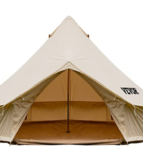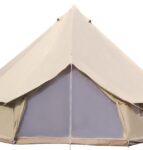Canvas tents are a staple of backcountry camping. They provide a cozy shelter from the elements, a place to cook and eat meals, and a place to relax. With that in mind, it makes sense to want to be able to use your canvas tent over and over again. That’s why it’s worth learning how to waterproof a canvas tent. Even though canvas tents are incredibly durable, they are prone to water damage. The problem is that waterproofing canvas tents is challenging. The good news is that there are ways to waterproof a canvas tent that won’t take up too much time, cost a ton of money, or significantly reduce the lifespan of your tent. With that in mind, keep reading to learn how to waterproof a canvas tent and save your investment.
What’s the Best Way to Waterproof a Canvas Tent?
You’ll need to waterproof your tent in a few different ways. The most effective way to waterproof a canvas tent is to waterproof it with a waterproofing spray. This is a two-part epoxy that you apply to the inside and outside of your tent. You’ll apply the spray to the inside of your tent, wait a few hours, and then apply the spray to the outside of your tent. Although it can take a little longer, a layer of polyethylene is also an effective way to waterproof a canvas tent. With this technique, you’ll install a layer of polyethylene inside your tent to make it waterproof.
How to Waterproof a Canvas Tent with a Layer of Polyethylene?
The easiest way to waterproof a canvas tent is to install a layer of polyethylene inside your tent. This is a synthetic waterproofing material that waterproofs fabrics. It’s inexpensive and simple. The first step is to prepare the floor of your tent. You’ll need to put down a layer of plastic to protect the tent floor. Simply lay down a large piece of plastic and then put your tent down on top of the plastic. Once your tent is down, it’s time to add the polyethylene. This can be done with a few different methods. The easiest method is to lay the polyethylene inside the tent while it’s unzipped. The next method is to lay the polyethylene inside the tent and then zip the tent back up. The last method is to lay the polyethylene inside the tent and then tape the polyethylene to the inside of the tent. Once the polyethylene is in the tent, you can finish and seal the polyethylene with an outdoor spray. The outdoor spray keeps the polyethylene dry and protected from the elements.
How to Waterproof a Canvas Tent with Damp-Ceiling Tarp?
If you have the time to waterproof canvas tents with polyethylene, it’s a good idea. However, it takes up to two weeks for drying and can be quite frustrating. If not, you can speed up the process by applying a layer of polyethylene with a damp-carpet tarp. A damp-carpet tarp is a waterproof material that you can use to apply a layer of polyethylene to a canvas tent. The tarp is made out of a synthetic material that’s used to put down carpets. It’s lightweight, portable, inexpensive, and effective. The first step with using a damp-carpet tarp is to find a location that’s both sheltered and protected from the rain. You want to make sure that your location is both sheltered and protected from the rain. You can use the tarp when the weather is good or bad. When it’s bad, you can use the tarp to put down a layer of polyethylene. When the rain stops and the sun comes out, you can remove the polyethylene from the tarp and use it again for other purposes.
A layer of polyethylene is an effective way to waterproof a canvas tent. The problem is that it takes a long time to dry. If you have time for this process, it’s a good idea. If not, you can speed up the process by applying a layer of polyethylene with a water-repellent spray. A water-repellent spray is a two-part epoxy that you apply to the inside and outside of your canvas tent. It’s a waterproofing spray that you can use to waterproof your canvas tent. With a water-repellent spray, you’ll apply the spray to the inside of your tent and then wait a few hours and apply the spray to the outside of your tent. Although it can take a little longer, a layer of polyethylene is also an effective way to waterproof a canvas tent. With this technique, you’ll install a layer of polyethylene inside your tent to make it waterproof.
How to Waterproof a Canvas Tent with a Rainfly?
A layer of polyethylene is an effective way to waterproof a canvas tent. The problem is that it takes a long time for the thin material to dry – if you have time, this process would be good though. If not, you can speed up the process by applying a layer of polyethylene with a rainfly. A rainfly is a waterproof cover that you can use to waterproof a canvas tent. A durable rainfly is a great way to waterproof a canvas tent. It’s also a great option if you’re going to be camping in inclement weather for a significant period of time. With a durable rainfly, you’ll install a rainfly on top of your canvas tent. This rainfly is designed to provide waterproof coverage. It’s also designed to keep water out of your tent. After your tent is covered with a rainfly, you can finish and seal the rainfly with a layer of polyethylene. This is a two-part epoxy that you apply to the inside and outside of your canvas tent. It’s a waterproofing spray that you can use to waterproof your canvas tent.

Conclusion
At the end of the day, waterproofing your canvas tent is all about taking your time and doing things right. You’ll want to carefully prepare your tent by wiping it down with a tack cloth, installing a groundsheet, and equipping your tent with everything you need. You’ll also want to make sure that you fully understand the process of how to waterproof a canvas tent and that you follow instructions to the letter. Otherwise, you risk damaging your investment. Finally, it’s worth noting that waterproofing a canvas tent doesn’t have to be a time-consuming or expensive process. With the right materials, your tent can be waterproofed by anyone. With those tips in mind, you can ensure that your canvas tent is as waterproof as it can be.



